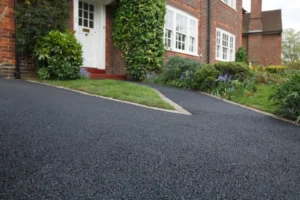Are you tired of navigating through muddy paths that resemble a swamp? Look no further!
In this ultimate paving material guide, we will explore the top five materials – concrete, brick, gravel, limestone, and tile – to help you make an informed decision for your next project.
Whether you desire durability, elegance, or versatility, we’ve got you covered. Get ready to transform your pathways into sturdy, eye-catching masterpieces that will withstand the test of time.
Let’s dive in!
Pros and Cons of Concrete
Concrete is a versatile option for your pathway. It starts hardening in just two hours and can reach full strength within a few days. Its cost-effectiveness, durability, and low maintenance make it a popular choice for many homeowners.
Concrete is made up of a mixture of cement, aggregate, and sharp sand. The proportions of these components determine its strength and suitability for different purposes.
When installing a concrete pathway, it’s important to ensure the correct depth of material and proper sloping for excess water runoff. This will help prevent water pooling and potential damage to the pathway.
With proper installation and maintenance, a concrete pathway can last for many years. It provides a sturdy and reliable surface for your outdoor space. Regular cleaning and sealing can help maintain its appearance and prolong its lifespan.
Benefits and Dilemmas of Brick
When choosing brick as your paving material, keep in mind the distance from mature trees with complex root networks. It is important to dig and flatten the proposed area for the path and add a layer of crushed stone and sand as a base.
By using a border, you can keep the bricks in place. Brick offers several advantages, such as its durability and timeless appeal. It can also enhance the overall look of your landscape. However, there are some disadvantages to consider.
Brick can be more expensive than other paving materials, and it requires more maintenance, such as regular cleaning and sealing. Additionally, brick may not be suitable for heavy traffic areas. Overall, brick can be a great choice for your path, but make sure to weigh the pros and cons before making a decision.
| Advantages | Disadvantages |
|---|---|
| Durability | Higher cost |
| Timeless appeal | Requires maintenance |
| Enhances landscape | Not suitable for heavy traffic areas |
Gravel: A Versatile Paving Option
For a versatile and creative option, consider using gravel as your paving choice.
Gravel comes in a variety of colors, allowing you to create unique and visually appealing paths or driveways.
The different color options give you the flexibility to match or contrast with your existing landscape design.
Gravel can be used in various creative ways, such as creating intricate patterns or designs by mixing different colors together.
It can also be used to add texture and visual interest to your outdoor space.
Whether you want a rustic or modern look, gravel can be a great choice.
Additionally, gravel is easy to install and maintain, making it a practical option for homeowners who desire a beautiful yet low-maintenance paving solution.
The Allure of Limestone
Consider the allure of limestone for your outdoor space, as it enhances most informal gardens and is available in different colors.
Limestone is a durable material, making it a great choice for paving. It can withstand heavy traffic and is resistant to cracks and damage. However, it does require some maintenance to keep it looking its best.
Regular cleaning is necessary to remove dirt and debris. It is important to avoid using harsh chemicals or abrasive cleaners, as they can damage the surface of the limestone. Instead, use a mild soap or limestone-specific cleaner.
Additionally, it is recommended to seal the limestone to protect it from stains and moisture.
With proper care, limestone can provide a beautiful and long-lasting addition to your outdoor space.
Exploring the Charm of Tile
To explore the charm of tile, you can choose from a variety of non-traditional designs that can add a modern touch to your outdoor space.
Consider the cost of tiles, as they can range from affordable ceramic options to more expensive natural stone varieties.
When it comes to maintenance, tiled paths require regular cleaning and occasional resealing to keep them looking their best.
Here are three key points to consider:
- Durability: Tiles are known for their durability and can withstand heavy foot traffic. However, it’s important to choose the right type of tile for your outdoor space based on its intended use and climate conditions.
- Slip Resistance: Look for tiles with a slip-resistant surface to ensure safety, especially in areas prone to water or moisture. This will help prevent accidents and injuries.
- Drainage: Proper drainage is crucial for tiled paths. Ensure that the tiles are installed with a slight slope to allow water to flow away from the path, preventing water accumulation and potential damage.
Factors to Consider When Choosing Paving Material
When choosing the right material for your path, it’s important to think about the overall landscaping and drainage. Cost considerations and environmental impact are also crucial factors to consider.
Concrete is a popular choice due to its durability and strength. It is made of cement, aggregate, and sharp sand, and can be customized to suit different purposes. However, concrete can be expensive to install and has a high environmental impact due to the production of cement.
Brick is another option, but it should be kept away from mature trees with complex root networks.
Gravel is cost-effective and comes in various colors, but it requires a weed-resistant membrane to prevent weed growth.
Limestone offers a unique aesthetic but requires lifting for installation and a compacted gravel base for heavy traffic areas.
Tile provides a Victorian look, but it may require a professional tiler and has limited design options for modern properties.
Consider these factors when choosing your paving material to ensure the best fit for your needs.
Practical Tips for Paving Success
To ensure a successful paving project, make sure you choose a suitable depth for the material. Proper preparation techniques and maintenance tips are crucial for long-lasting results.
Preparation Techniques:
- Concrete: Determine the proportions of cement, aggregate, and sharp sand to achieve the desired strength. Slope the surface for efficient water runoff.
- Brick: Keep a safe distance from mature trees with complex root networks. Dig and flatten the proposed area, then add crushed stone and a layer of sand as a base. Lay the bricks on top and use a border to keep them in place.
- Gravel: Dig a trench and line it with crushed stone. Cover with a weed-resistant membrane and fill the trench with gravel. No need to slope the path for water runoff.
Maintenance Tips:
- Limestone: Lift the stones for installation and create a compacted gravel base for heavy traffic paths. Adjust the height by adding or removing sand under each stone.
- Tile: Consider hiring a professional tiler for a Victorian look. Non-traditional tile designs can be used for modern properties. Think about overall landscaping and drainage when choosing the paving material.



